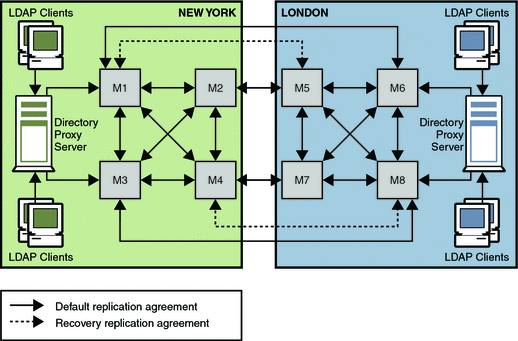Using Replication for Availability Across Two Data Centers
Generally in a deployment with two data centers, the same recovery strategy can be applied as described for a single data center. If one or more masters become unavailable, Directory Proxy Server automatically reroutes local reads and writes to the remaining masters.
As in the single data center scenario described previously, recovery replication agreements can be enabled. These agreements ensure that both data centers continue to receive replicated updates in the event of failure. This recovery strategy is illustrated in Figure 12–3.
An alternative to using recovery replication agreements is to use a fully meshed topology in which every master replicates its changes to every other master. While fewer replication agreements might be easier to manage, no technical reason exists for not using a fully meshed topology.
The only SPOF in this scenario would be the Directory Proxy Server in each data center. Redundant Directory Proxy Servers can be deployed to eliminate this problem, as shown in Figure 12–4.
Figure 12–3 Recovery Replication Agreements For Two Data Centers

The recovery strategy depends on which combination of components fails. However, after you have a basic strategy in place to cope with multiple failures, you can apply that strategy if other components fail.
In the sample topology depicted in Figure 12–3, assume that Master 1 and Master 3 in the New York data center fail.
In this scenario, Directory Proxy Server automatically reroutes reads and writes in the New York data center to Master 2 and Master 4. This ensures that local read and write capability is maintained at the New York site.
- © 2010, Oracle Corporation and/or its affiliates
